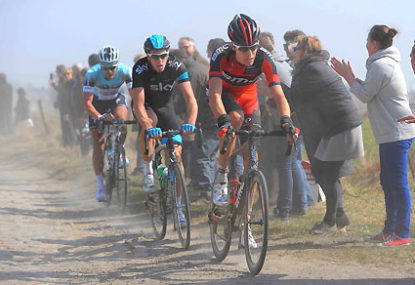'I've just won a stage of the Tour de France, mate!': Hindley grabs yellow jersey as Aussie blows Tour apart
Australia's Jai Hindley has said he is "lost for words" after a shock stage victory at the Tour de France earned him the leader's…

The first weekend of racing in northern Europe opens the traditional part of the road cycling year. We are one month away from some the oldest races in the sport: the Spring Classics.
Road cycling is a fascinating mix of old and new. The latest technology used to fight for victory over some of the oldest roads in the world.
Training, like the bikes, is cutting edge now, but just like today’s bikes have the same design DNA as those used for the first Tour de France, training is underpinned by some time-tested principles.
Even the most science-dazzled coach knows there’s still a place for what British Cycling’s head trainer Shane Sutton calls “hard yards”. And nowhere is training more traditional than preparing for the cobbled Classics.
But first, what sort of animal is a cobbled Classics rider?
The great Italian coach Aldo Sassi said top pro road racers split into two groups. Both have a high VO2 max, but where Grand Tour riders can access a high percentage of it for a long time, Classics riders access an even higher percentage, but in much shorter bursts.
So for Grand Tour success you need a high powered lean-burn engine, and for the Classics you need more power but just for long enough to break the rest. And in each case the core ability must be repeatable within the timeframe of the race, and it must be underpinned by a vast well of stamina.
Cobbled Classics riders must know the terrain they race over like the back of their hand, and they must know the races. It also helps if you can sprint.
The best have all these abilities, but in different proportions.
Fabian Cancellara has the repeatable power, as does Tom Boonen, but he has a killer sprint too. And although they both know the races, nobody knew them like Peter Van Petegem.
He had the power, he could look after himself in a sprint, but Van Petegem could ghost at the back of any group yet still be at the front after each selection.
He spent his life studying the Tour of Flanders route, living in the middle of the lumpy Flemish Ardennes where the race is decided.
He once told me, “It doesn’t matter what the weather is like or where the wind blows from, on race day I’ve already ridden the cobbles and climbs in exactly the same conditions.”
But while knowing the course and how to keep in contention is one thing, so is having the killer power. The training still has to be done.
One of the latest pro training protocols is EDP – explosive power development intervals.
Team Sky laid claim to inventing this technique when their coach Tim Kerrison revealed it was a key part of Chris Froome’s preparation for the 2014 Tour de France, but Classics riders have done this stuff for years.
A successful attack depends on getting a gap then making it stick. To do this, riders need explosive power then the ability to hold a high percentage of VO2 while their muscles drink the lactate produced in the attack.
EDP intervals start with a 15-to-20-second flat-out sprint. The rider then backs off for a few seconds to recover, then goes straight into a ten-to-15-minute effort at flat-out time trial pace.
What they’re doing is simulating attacking then working to get a break established.
Another session is the ubiquitous 40/20s. That’s a 40-second flat-out sprint followed by 20 seconds recovery. Ride like that for five minutes, ride easy for five, then repeat until four full sets have been done.
Keep riding, and repeat the four sets of five 40/20s later during the same ride.
This training builds power, but it also triggers processes that deal with and use lactate in the muscles to produce energy. It replicates what’s going on inside a rider’s body at crucial times of a one-day race. And it directly replicates the scenario that you see on TV in the Classics – often it’s the third or fourth attack that works.
Finally, these sessions are put together in periods of overload training, after which, given sufficient rest and good nutrition, the body goes into a period of super-compensation.
A rider training for the Classics might do days of intervals back-to-back. They will also include intervals as part of much longer rides, maybe even of the same duration as the race.
They’ll also ride small races without tapering before or after, and might train before or after the race, or even do both.
Such a period could be one week of 30 hours training, or two of 25 hours each. The rider will be tired at the end, and probably tired during the overload. But the training stops two or three days before the target race, when our rider rides a little and rests a lot.
Then their minds and bodies are begging for somebody to say “Three, two, one – Go!”
A full broadcast guide for the 2014 Spring Classics can be accessed here.